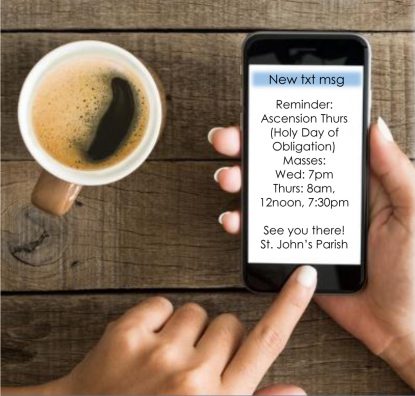 You flip through it, fold it, and (on hot days) fan yourself with it. You tack it to the fridge for reference.
You flip through it, fold it, and (on hot days) fan yourself with it. You tack it to the fridge for reference.
It’s the church bulletin, that venerable source of parish news. From Mass schedules to bingo, the bulletin has long been required reading for parishioners in the know. Forgot about a holy day of obligation or an important fundraiser? You should have read the bulletin.
But with more people – especially young people – turning to online sources for news, the Archdiocese of Philadelphia will host a workshop to take a fresh look at the parish bulletin in the digital age.
“The Bulletin and Beyond: Building a Parish Communications Plan for the 21st Century” is designed to show parishes how email and text messages can enhance parish messaging – without breaking the budget or overwhelming parish staff.
[hotblock]
The half-day workshop will be held Friday, Feb. 10 from 9 a.m. to 12:30 p.m. at St. Charles Borromeo Seminary’s College Auditorium, 100 East Wynnewood Road, Wynnewood. The cost is $20 per person, which includes morning refreshments. Register at phillyevang.org/events or email phillyevang@archphila.org.
“Emails and texts, along with the printed bulletin, help to create connectedness,” said Meghan Cokeley, director of the Office for the New Evangelization, who is coordinating the workshop. “We have to acknowledge that the printed bulletin is generally not reaching the young, who are increasingly – even exclusively – accessing information through their mobile devices.”
And since it’s usually tucked in the back of church, “the printed bulletin only reaches people who actually come to Mass,” Cokeley added. “At least 80 percent of registered parishioners don’t attend Mass, so emails and texts might be the way to open the door and bring them back in.”
Among digital communications channels, email and text messaging are the most manageable. “They’re more bite-sized, more digestible,” Cokeley explained. “Social media platforms – such as Facebook, Twitter and Instagram – are much more time-consuming, and they actually end up requiring parishes to hire more staff.”
For about $500 a year, a parish can add email and text messaging to its communications plan. But how does a parish get started with building its email list?
“You can collect addresses in a number of ways – using forms in the pews, having sign-ups after Mass, calling your parishioners,” Cokeley said. “Regardless of how you collect addresses, though, be clear about the frequency of your proposed emails. Don’t bombard your recipients; in fact, you shouldn’t send messages more than once per week. Moderation and regularity are key.”
It’s also important to craft effective emails, and the workshop will explore strategies for doing just that.
“For starters, the long paragraphs have got to go!” Cokeley laughed. “One way to find the appropriate email length is to draft your email, and then cut 70 percent of what you’ve written. We need to put ourselves in the mindset of the modern reader.”
And despite the sheer volume of information available to that reader, email and text messaging can make a significant difference in parish communications.
“You can double your holy day Mass attendance simply by sending a text message reminder a few days beforehand,” Cokeley noted, citing a statistic gathered by workshop leader Matthew Warner.
Warner is the founder and CEO of Flocknote, a mass communication tool created specifically for parish use. Although he’ll describe the various features of Flocknote in detail at the workshop, Warner has designed his talk to be broadly relevant, whether or not attendees use his product or consider themselves tech-savvy.
[hotblock2]
“Ultimately, the goal is to bring everyone to Mass,” Cokeley pointed out. “The main objective of this workshop is very simple. A lot of folks running the communications outreach in parishes are regular Joes, not techies. This is about having a plan and the discipline to implement it.”
Does this spell the end of the printed bulletin?
“It’s still very important,” Cokeley said. “In fact, when we were developing this workshop, we swapped the word order in the original title, from ‘Beyond the Bulletin’ to ‘The Bulletin and Beyond.’ I’m a huge proponent of not getting rid of the bulletin, and there’s a theological reason for that.
“Catholicism is an incarnational religion; Christ became flesh. As a result, the church does not function solely in a virtual reality. It’s important to have the physical, tactile presence of channels such as the printed bulletin.”
Cokeley also encourages parishes not to despair that their communications are lost on an increasingly secular world.
“John Paul II reminded us that truth has its own gentle persuasion,” Cokeley said. “That’s the work we can’t accomplish, but we can at least present it – in print, in email, in a message on your phone. The question is whether we can communicate something of the beauty and splendor of our faith that will kindle an attraction to Christ. In the end, it’s the work of grace that brings people here. Our technology doesn’t supersede grace. We create the conditions favorable to a response.”
Sponsors for the workshop include CatholicPhilly.com, the archdiocesan Office for Communications, Office of Information Technology and Office for the New Evangelization, as well as St. Charles Borromeo Seminary’s Office of External Affairs.
PREVIOUS: Catholic Charities Appeal aims to give hope to all in need
NEXT: $350K gift will help renovate St. Joseph’s Sisters’ retirement home



Share this story